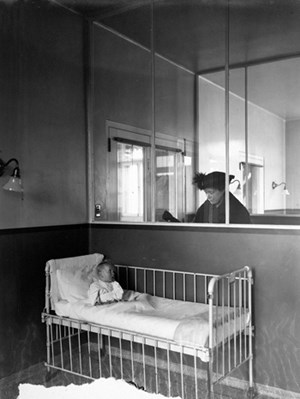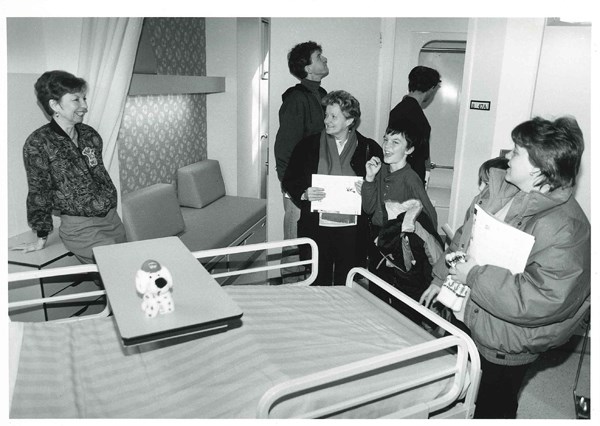From closed doors to sitting at the table: The birth of child and family-centered care at SickKids
Summary:
Today, SickKids has a comprehensive model of child and family-centred care that recognizes the child is at the core of care and the family is central to the child’s life and therefore central to their care as well. However, looking back at SickKids’ history, it wasn’t always this way.
By Jessamine Luck, Intern, Communications & Public Affairs
When a patient comes through the doors of The Hospital for Sick Children (SickKids) they are rarely, if ever, alone. Each patient brings with them a unique set of circumstances and people who will have a profound impact on the medical care they receive. Today, SickKids has a comprehensive model of child and family-centred care that recognizes the child is at the core of care and the family is central to the child’s life and therefore central to their care as well. However, looking back at SickKids’ history, it wasn’t always this way.
Visiting hours are over

As germ theory took hold in the late 1800s, hospitals became restrictive to the outside world. Whereas previously parents had been encouraged to visit they now found barriers separating them from their children. At the time, keeping ill patients away from family members who had the potential to spread germs and disease was thought to benefit the patients both physically and psychologically.
Well-meaning health-care practitioners believed the arrival and departure of parents on the wards disrupted the children’s routines, caused undue stress and interfered with recovery. This was reflected in the restricted visiting hours at the time which dictated parents could only visit on one or two afternoons per week for one hour at most.
A changing tide
By the mid-20th century, opinions on family involvement in medical care began to change. A growing body of scientific evidence demonstrated the importance of incorporating constructive activities and a cheerful atmosphere during prolonged hospitalization for children. Psychologists began advocating for daily visitation and organized play, pointing to studies showing visitation and emotional connection were crucial for development.
This new way of thinking was at odds with the traditional medical philosophy but soon, more family-friendly models began to take hold. Gradually, visiting hours expanded to two hours daily then nine hours daily and eventually “visiting hours” for family became a thing of the past.
“We have designed this hospital for children and their parents, rather than the staff.”
Although state-of-the-art in the 1950's, SickKids was in need of an upgrade by the 1980's. Parents were frequently spotted sleeping wherever they could find space and had to line up for the limited washrooms they could use. The physical facilities of the hospital were no longer in line with its philosophy of caring for the whole family.
When SickKids began designing the new Patient Care Centre (now the Slaight Family Atrium) in the 1980s, parents were encouraged to offer their opinions on the plans and serve formally on hospital committees. The results of their input could be seen directly on the new inpatient units. Each unit featured single patient rooms with private washrooms, sleeping accommodations for one parent including a day bed and storage, and a playroom on each unit.
Finally the hospital had a physical expression of its child and family-centered care philosophy. Dr. Robert Haslam, Paediatrician-in-Chief at the time, summarized the intent perfectly, “we have designed this hospital for children and their parents, rather than the staff.”
Having a seat at the table
Today, family-centred care goes beyond extended visiting hours and a space for parents to sleep.
“The concept of child and family-centred care has evolved over the last century with a better understanding, today, of the importance of the family in a child’s life and health. I believe that we will continue to see positive advances as greater importance is given to the voice and experience of patients and families. Families must be recognized as true partners in decision-making related to the care of their children, and their experiences must inform the shaping of the health-care system moving forward,” says Karima Karmali, Director, Centre for Innovation & Excellence in Child and Family-Centred Care at SickKids.

SickKids patients and caregivers partner with hospital staff as part of the Family Advisory Network and serve on a variety of formal committees including the Children’s Council and Family-Centered Care Advisory Council. . These advisors provide a unique perspective and make a difference at all levels of the hospital. Family advisors consult on wide-ranging hospital initiatives and have impacted several policies such as nursing shift handover at the bedside.
Nursing shift handover happens when a nurse arrives on a unit to begin their shift and is briefed by the outgoing nurse about the current status of their patients. Families emphasized the importance of these conversations happening at the bedside to give them the opportunity to hear information about care, share their own information and ask questions.
Family advisors also lead their own projects within the hospital. Families Connecting Families is a sub-committee of the Family Centered Care Advisory Council and is focused on peer support and creating opportunities to connect families on topics relevant to their shared experiences. Another example is the development of a comprehensive family orientation process for inpatient units.
What these initiatives all have in common is the demonstration of putting children and families first. Not only does child and family-centered care provide a better experience for patients and families but it creates a better experience for health-care providers and ultimately, better health outcomes.

